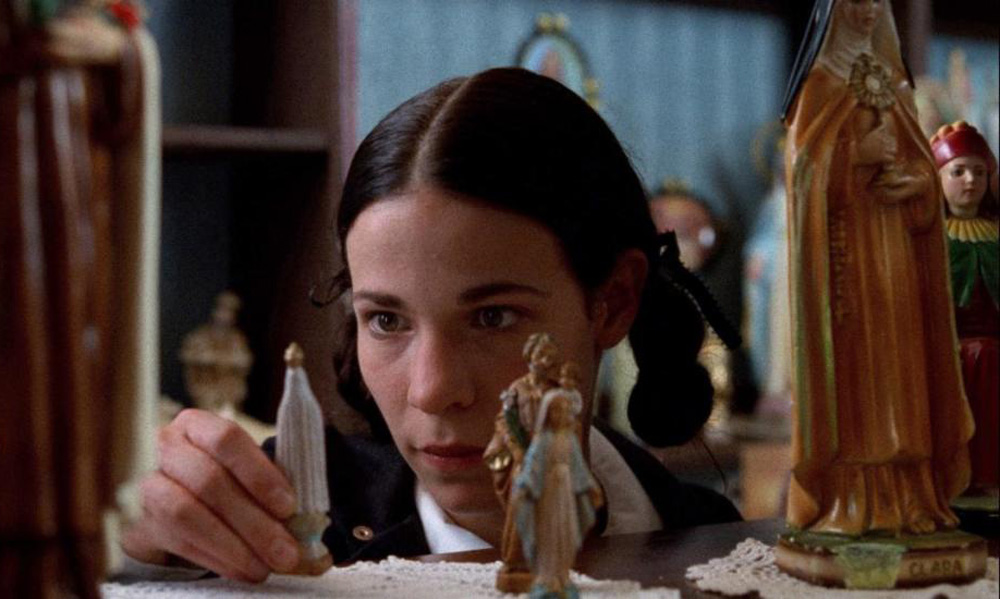The introductory scene of “Household Saints” couldn’t be more pedestrian – or magical, set in a suburban backyard during the summer where all the surrounding garden is in bloom and the mood is ripe for storytelling as a pair of grandparents look to entertain the family they’ve assembled. Their voices introduce Nancy Savoca’s spellbinding third feature, but even once they can’t be explicitly heard, you can feel them leave their impression on the tale that unfolds, full of idiosyncrasies and digressions that will mean something later as they speak over a lunch of leftovers about the best sausage they ever had from Santangelo’s, a butcher shop where it was believed that Teresa (Lili Taylor) had no less than God guiding her fingers to knead the meat.
You believe it to be true against any conventional wisdom when it’s related so confidently by Savoca, slyly navigating her way through an adaptation of Francine Prose’s multigenerational family saga where you actually want to know how the sausage is made, but some things remain a beautiful mystery. Teresa’s gifts appear to have been passed down from her grandmother Carmela (Judith Molina), who labored tirelessly as all the women in her Italian family before her to be a homemaker, but they took a circuitous path when her mother and Carmela’s daughter-in-law Catherine (Tracey Ullman) never fit the mold upon marrying Joseph (Vincent D’Onofrio), who took over the family butcher’s shop and famously secured his wife’s hand in marriage during a pinochle game with her father. Savoca tenderly observes how each of the Santangelos has played the cards they’ve been dealt following World War II where the tradition-bound neighborhood of Little Italy in New York isn’t entirely immune to shifts in the culture going on around it and each finds their own way of making sense of a world they can hardly control, occasionally stumbling onto good fortune they can interpret as luck, as Catherine might, or divine intervention as Teresa, who comes to embrace a deep sense of faith, does.
Beyond the story at hand and how enrapturing it is, “Household Saints” gives reason to believe in something greater when its own path to the screen seems improbable and its return to theaters this week in a striking new 4K restoration seems even more so. Even after establishing herself as a formidable talent with the Sundance sensation “True Love” and her big studio breakthrough “Dogfight,” Savoca still had an uphill climb to put the film she had been thinking about making from the time she was in film school when she first read Prose’s book into production, enlisting the help of Jonathan Demme, among others, to help shepherd it to the screen and keep her distinct vision for it intact. Resplendent now with attention to detail that the good folks at Milestone Films put into bringing it back to its original glory, there was a period of time when it was thought the film which had been acquired by Fine Line Features in 1993 might be lost forever when Savoca and her husband and producing partner Richard Guay couldn’t locate a print to screen and it never received anything more than a home video release on VHS.
As part of the newly undertaken Missing Movies initiative, the elements were rediscovered to strike new prints and the film itself now feels like uncovering a buried treasure with a host of exquisite early performances from Taylor, Ullman, and D’Onofrio as well as Michael Rispoli as Catherine’s brother and Michael Imperioli as Teresa’s boyfriend, and also is bound to remind audiences of the trailblazing work of Savoca, who may never have been easy to pin down as a wily storyteller, but has long had a knack for nailing the wild human experience. With some stops on “Household Saints” revival tour accompanied by Savoca’s early shorts and a new making-of-doc about the 1993 film, the director is receiving the kind of attention she’s always deserved as the film is being made the true event it deserves to be and recently she graciously spoke about how filmmaking has become a true family affair when her daughter Martina Savoca Guay directed the doc “The Many Miracles of Household Saints,” having the faith in herself to pull off such an unconventional narrative and the surprises it continues to have in store for her.
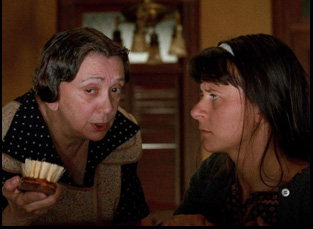
It was wonderful. It’s a lot of material that all of a sudden is out there because we discovered the movie was lost — all the elements and all the materials and the rights — when we found the elements, we found an electronic press kit and our distributors at Milestone Film suggested that we could put together a little doc of that stuff that’d be fun to have as a DVD extra. But then my daughter, who’s a filmmaker, was like, “I’ll take the material and see what I can do.” And I was pregnant with her [during the making of “Household Saints”], so I’m like, “Yes, that would be fun,” and she did a one-hour documentary called “The Many Miracles of Household Saints,” and they’re showing my student films because that’s also [part of] the DVD extras.
As far as the doc, did you have any idea what your daughter would make of it or did you just hand her the box of materials?
No, I wanted her to do her thing because first, she’s a filmmaker, but also, I made the movie, so that was what I needed to do and this material that was behind the scenes and interviews, it was kind of emotional for me. I couldn’t really watch it. I started to, and then it just like, “Phew. How great that for her, she’s coming at it with something really different.” And we used to call her the “Household Saints Baby” and she [wondered], “Well, what did that ever mean?” Because for her, she just knew she had that nickname.
That’s incredible. So you at least had to approve a master for this – what was it like watching the restoration when all was said and done?
Oh, like a kid in a candy store. It was wonderful. We were invited in early on by Milestone, who were super generous and we had wonderful, wonderful people that are all in the credits — wonderful technicians, colorists, sound designers, and everyone recreating this with a lot of respect towards the original. I was given all the leeway I wanted and if I wanted to change it completely, I actually could have, but I was just also feeling like this movie was this movie and let’s just preserve it. And Bobby Bukowski was my DP and Kalina Ivanov was my production designer, and what they did with the resources we had is incredible.
It was miraculous watching it because even prints that we saw back in the day, they’d be beat up from just being shown around and then what ended up happening is all we ever had was a VHS cassette. I really appreciated that a fan put it up on YouTube — and that was probably the worst version of it, so I appreciated that they liked it so much, but this is what people see when they see this movie and now it’s like heaven.
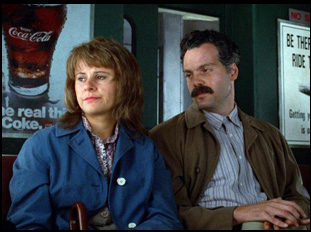
Yeah, I totally get Carmela now. I know the grandma. [laughs] I feel like I’m going to really turn into her very soon, so I’m excited about that. But what’s so wonderfully surprising for me is the movie is almost like a kid that grew up and left home and did stuff. and now they came back to live with me for a while. There’s a new generation seeing the film, and I feel like it really is something now that just stands there on its own and I don’t mess with it too much. I don’t watch it with audiences now because I get too nervous, but I watched it when it was being restored and it really moved me. I felt very close to the story, and it moved me all over again in different ways and in deeper ways because I didn’t have the responsibility of having a movie out and all weighs on you as a filmmaker when it first comes out, so I’m enjoying it more.
I hope so, and in revisiting it myself, I had forgotten how unusual the structure was. Was this difficult to put together?
No, unfortunately that’s the way my mind works. [laughs] But the tone of the novel Francine wrote is what I really, really respected and really wanted to recreate for an audience cinematically, so I was really aware of that. And all I kept thinking of was my family. It’s like my mother, the Argentinians in my world and the Sicilians too, because they had to do it too. They talk to dead people. We believe in whatever it is we see out of the corner of our eye. We get vibes. That’s been a part of my upbringing, so I drew on a lot of that and I found in the book that there was a way for me to use the things I grew up with and mix it up with Francine’s story.
One of the things that was pointed out in the press notes that I only realized later was part of how engrossing this all was were the lengths that you went to to get insert shots to create this detailed world and you also pull off the more surreal elements practically. Why was that so important to you at the time?
That was very much designed when I was trying to figure out. Certainly we were on a budget for the ambition of the story and the scope of what we wanted to do and I felt always felt like this was opera. And then you get a budget that’s little, and you’re [thinking] how am I going to make an opera with this budget? And I had to articulate what I wanted things to look like and even if I had a bigger budget, I would not have wanted special effects. I did not want it to look slick. There was something about this movie that was very homespun, so we did in-camera tricks, like superimpositions [where] we would just rewind the film and then shoot over it. It was very much [inspired by] the way those grandmas cook — whatever you have at hand, that’s how you’re going to make your meal.
So we wanted to do our effects that way and the closeups came in because this is a movie that’s so much about miracles and how we don’t pay attention to them and how they’re very ordinary. I realized that the way that that could happen is if I treated the everyday very, very special — that includes looking at something super close so that if [Carmela’s] making sausage, it’s not like she’s making sausage and you see a medium shot of her. It’s like you’re with her doing it and you get into the zone with her, so I could show that the everyday had this miraculous feel to it. Then when Jesus shows up in Teresa’s bedroom, or when Enzo shows up for Carmela, they’re just guys sitting in a chair that show up in the room, and we would call those the big miracles. but they are very ordinary, so we flipped that and it became this really fun thing. And I remember talking to every department head and saying, “Here’s what I want you to please keep in mind when you get your new ideas, the ordinary is going to be extraordinary and the extraordinary is going to be ordinary, so if we could just all work on that together…” and that’s what happened.
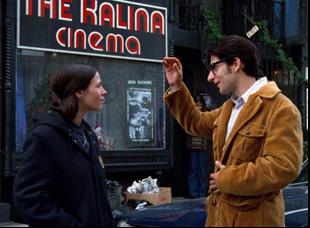
Well, I had worked with her on “Dogfight” and it was towards the end of “Dogfight” that we were starting to say, “Okay, our next movie, we’ve got to do ‘Household Saints.’ If we’re not going to do it now, I don’t know how we’re ever gonna get it done because it was so unusual.” And I started talking to Lili about it because I think she had the qualities of Teresa. It was a totally different character from Rose in “Dogfight,” but something about her earnestness and her ability to believe in something way big, and she really got really excited about that. We started sharing books with each other — “Saint Stories,” and she found a book called “Holy Anorexia” that was so, so informative for me and it just became this conversation that just kept going. And with Lili, I could give her photos, movies, music to listen to, whatever and I don’t know how actors do it — that’s the beauty and the magic that I enjoy watching — they just take all this and internalize it, then they show up on the set and suddenly everything you talked about is there. It’s not there intellectually, it’s there in their bodies.
From what I understand, Jonathan Demme played a pretty crucial role in making the film a reality and had previously invested in “True Love.” What was he like to have around on this?
I’ve had the privilege of seeing a few directors on set working, and Jonathan, if I have one word to describe him, it’s “cheerleader.” He was the most inspiring, inspirational person and every time he heard something anybody was doing, he was like, “That’s great, that’s fantastic. I know you can do this,” and to hear this as a young filmmaker from a guy that had done so many movies I admired… And the funny thing with Jonathan is that right around the time that we were starting to talk to him about being our executive producer — and mind you, “Household Saints” was not necessarily his bag. It wasn’t necessarily the kind of thing he did, but he was just so generous with his enthusiasm. And we accidentally ended up being his next door neighbor. That started the year that we ended up living with him for 13 years, just being really good neighbors – not like in our each other’s face every day, but often enough. The dogs and kids would cross the backyard and all that. I remember him seeing dailies from “Household Saints,” and if I’m not mistaken, that might’ve been the time when he was doing “Philadelphia” and I would watch his dailies, so it was just lovely.
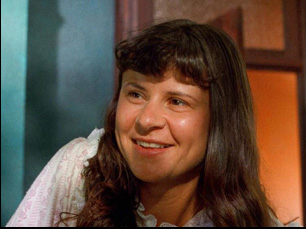
It’s funny, this movie just keeps surprising me. All I ever have done with this movie is follow it. I loved [the book] and I said it would be a great movie, and then I felt like it wanted to be, so I just followed it to try and get it to be a movie. Then it just kept doing what it needed to do. I felt like I was just there with it and I’m always surprised — and really in the best way — that people are interested. Some people find Catholicism in it, some people find Christianity in it, but some people will find something universal in it and that’s always so cool because that’s how I experience movies. One of my favorite movies is “Dog Day Afternoon.” Have I ever held up a bank? Have I ever had a lover that needed a sex change? No, but I understand Al Pacino’s character in that movie so well. I can’t explain why.
That’s the miracle of it ultimately. [laughs]
It really is.
“Household Saints” opens on January 12th in New York at IFC Center, including a special screening on January 18th of “The Many Miracles of Household Saints” and Savoca’s shorts “Renata” and “Bad Timing,” and will expand around the country starting January 19th. A full list of theaters and dates is here.




